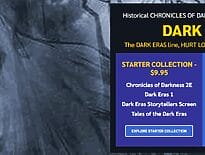For D&D 50th, D&D’s Chris Perkins was ‘roped’ into an interview with the marketing website Brands Untapped.
He was there, I think, to tackle when D&D became a brand but just two questions in Deej Johnson, the interviewer, asked what he actually did. Perkins is the “Game Design Architect” at Wizards of the Coast.

The answer;
These days, my primary responsibility is to manage the team of designers and editors who create official DUNGEONS & DRAGONS tabletop game products. I also assist and advise other D&D teams as well as business partners. As a D&D steward, I also have the privilege of representing this game I love at conventions and elsewhere. Much of my time is spend in meetings and answering email, but I always carve out time to creatively contribute to the game.
There you go… a lot of management, but it’s pleasing to see that he finds time for ideas for the game.
I was also curious about the mention of Dungeons & Dragons The Making of Original 1970-1977. That’s a non-fiction about D&D for the 50th anniversary.
Perkins was asked what else he wanted to say about D&D and talked about not having worked with everyone who’s contributed to the game. Perhaps just plug a plug in the history book?
I’ve been lucky to work with many of the greatest contributors to DUNGEONS & DRAGONS… But not all of them – despite my many years working on the game! I don’t know the game’s complete history. Few people do. But in June, we’ll be releasing The Making of Original D&D: 1970-1977 – that will offer a glimpse at how the original game came to be. There are many stories yet to tell!
As we did for the Chris Cocks article, let’s summarise the rest of the D&D as a brand article.
Who is Chris Perkins?
- Chris Perkins is a veteran Game Architect in the Dungeons & Dragons studio at Wizards of the Coast.
- He has a long history with the game, having worked on it professionally since his teenage years and full-time for the last 27 years.
When did D&D become a brand?
- D&D became a brand in the 1980s when similar games started appearing, indicating its influence.
- This decade also saw D&D expand beyond the core game with cartoons, novels, and video games.
- Today, D&D is a full-fledged franchise with products across various categories, solidifying its brand status.
How has D&D matured?
- D&D has become widely popular and recognized, earning the title of “world’s greatest roleplaying game.”
- References to the game are prevalent in popular culture, showcasing its influence.
- Recent releases like a Hollywood movie and an award-winning video game (Baldur’s Gate 3) further solidify its place.
- Increased accessibility through live-streaming, active play, social media, and online gaming has contributed to its mainstream status.
What are the edition wars?
- D&D is currently on its fifth edition, which incorporates elements from all prior editions.
- Each edition has its dedicated fans who debate which one is the best online.
- These “edition wars” didn’t affect the development of the current edition, which aimed to combine the best aspects of all previous versions.
What’s the best way into D&D?
- While movies and video games offer a glimpse into D&D, many learn the tabletop game through:
- Watching online streams
- Trying it out at conventions
- Learning from friends and family who already play
- Starter products like the D&D Starter Set and D&D Essentials Kit offer beginner-friendly ways to get into the game.
What does Chris Perkins want to talk about?
- Dungeons & Dragons has evolved significantly over its 50-year history, thanks to the contributions of many people.
- Hundreds of individuals have shaped the game, extending beyond the original creators.
- These contributions are equally important to D&D’s history, particularly those from the 1980s onwards.
Quick Links
- D&D history: Dungeons & Dragons The Making of Original 1970-1977.
- Original interview: Brands Untapped.

